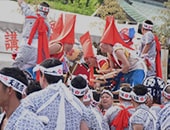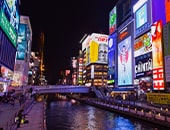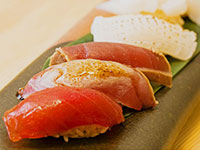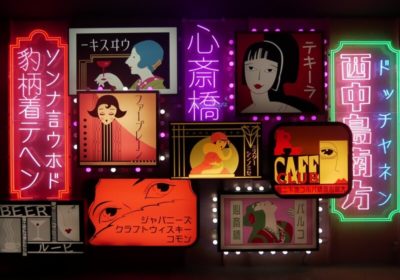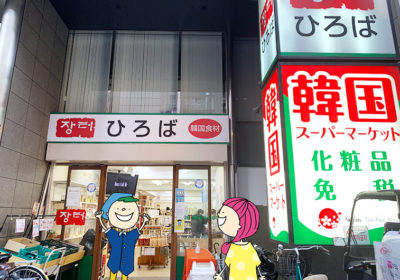

Osaka Bob FAMILY
Ten of the Coolest and Cutest Goshuin Stamps from Shrines and Temples in and around Osaka
Hello! Yuka here♪
The air is cool and crisp this time of year. It’s the perfect season for a nice walk outside.
Which means it’s also nice walk around shrines and temples.
And when you go to a shrine or temple, having a goshuin book will make your visit even more enjoyable! Goshuin are stamps specific to the temple or shrine you are visiting and are inscribed with other details, like the date of your visit. In order to get your own goshuin, you’ll need to visit a temple or shrine office and pay a small fee. They are highly stylized and beautiful to look at. And they are specific mementos from your trip that are unique to you and your journeys.
Collecting goshuin is trendy among teenage girls and young women. It’s so popular among this demographic that here’s even a term for these young women—goshuin girls!
So I’d like to show you where to go in and around Osaka to collect goshuin stamps so you can take part in the fun too. Here are 10 recommendations for shrines and temples in the Kansai region, mainly Osaka.
[Contents]
- Japan’s Head Sumiyoshi Temple—Sumiyoshi Taisha Shrine (Osaka)
- Gorgeous Stained Glass at Kureha Shrine (Osaka)
- Colorful Goshuin Stamps at Kotokuji Temple (Osaka)
- Ritual Laughing is a “Thing” at Hiraoka Shrine (Osaka)
- Ward Off Calamities at Hochigai Shrine (Osaka)
- The Head Shrine for Worshipping the Water God—Kifune Shrine (Kyoto)
- Cut-out Paper Art and Man’yōshū Poetry Goshuin at Mizudo Susano’o Shrine (Hyogo)
- Only Those Summoned by the Gods Can Go to Tamaki Shrine (Nara)
- 117 Temples at Shingon Buddhism’s Sacred Site—Mount Koya (Wakayama)
- The 3-legged Crow Yatagarasu as Seen at Kumano Hongu Taisha (Wakayama)
Japan’s Head Sumiyoshi Temple—Sumiyoshi Taisha Shrine (Osaka)
Sumiyoshi Taisha is affectionately called “Sumiyos-san” in Osaka. It is the head shrine of all Sumiyoshi shrines scattered across Japan. Sumiyos-san, has been revered as the guardian deity of seafaring since ancient times.
Legend has it that when you cross the arched bridge in front of the shrine you will be purified. This gorgeous piece of architecture is known as the Taikobashi Bridge. Be sure to cross this bridge when you visit this shrine.

Speaking of Sumiyos-san, the shrine is also known for Hatsutatsu-san, written first dragon and known as Hattatsu-san colloquially. People come here to pray for prosperity in business and safety within their households. If you visit the shrine on the first day of the Dragon each month, you will supposedly be protected by the deity. And if you visit the shrine 48 times in four years, they say your wish will come true. So if you are very dedicated, come to this shrine every month.


The goshuin I got at Sumiyoshi Taisha was a New Year’s limited edition design. It was embroidered with lucky cranes and pine trees, both symbols of longevity and good luck that are popular around this time of year. There was another design that featured the famous drum-shaped Taikobashi bridge. I can’t wait to see what new designs will be released in the coming year.
Gorgeous Stained Glass at Kureha Shrine (Osaka)
Kureha Shrine grants blessings for the prosperity of family businesses and improving handicraft skills. It is said that sisters Kurehatori and Ayahatori passed on the techniques of weaving and sewing, and the word gofuku (kimono cloth) and woven fabric was born here. Even nowadays, it seems that many people in the fashion industry still visit this shrine.

There are two large stained glass windows on either side of Kureha Shrine’s Main Sanctuary. It’s rare to see western culture in a shrine like this, so I couldn’t help but stop to get a closer look.
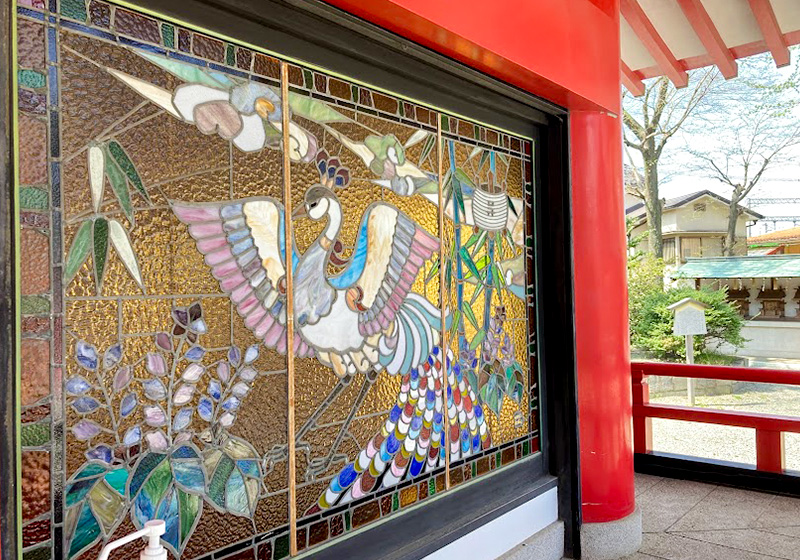
Colorful Goshuin Stamps at Kotokuji Temple (Osaka)
This temple was originally located in Sanadayama, a famous site during the historically significant battle—the Winter Siege of Osaka. The temple now blends into a quiet residential neighborhood. When you visit, you can get a colorful goshuin stamp that’s decorated with lots of handmade stamps.

The cats playing with the butterflies are so cute! It was so fun to see how the image took shape as I watched my goshuin being stamped with many different colors.

Besides the fact that designs change every month, there are also many limited edition goshuin such as the Rainy Day Goshuin, the First Day of the Moon Goshuin, and a number of designs for specific special days throughout the year. Some people try to collect them all.
I couldn’t decide which one to get when I visited, so I just got two.

Ritual Laughing is a “Thing” at Hiraoka Shrine (Osaka)
Hiraoka Shrine, the provincial Shinto shrine of Kawachi Province (the ancient province which covered the eastern part of modern-day Osaka Prefecture). Hiraoka Shrine is located in Higashi-Osaka City and is just a short walk from Hiraoka Station on the Kintetsu Nara Line. It has a deep connection with the famous Kasuga Taisha Shrine in Nara, and is sometimes called Moto-Kasuga. That’s why the guardian animal statues are deer, not lions. Isn’t that cute!

Hiraoka Shrine is famous for the Owarai Shinji (a Comedy Ritual) that takes place every December. After the chief priest says, “Ahahaha,” and all the participants laugh out loud with hearty “Ahahahas” for 20 minutes! It looks like a lot of fun. And it looks like we can have a great year with lots of laughter♪

Ward Off Calamities at Hochigai Shrine (Osaka)
There is a god enshrined at Hochigai Shrine enshrines who will protect you from calamities related to ill-fated directions and point you in the right direction. That means it is a good place for people to visit who are moving or building a new house. During the Heian period, pilgrims to Kumano always stopped here to pray for a safe journey. So it’s a good shrine to visit if you’re planning to travel.

The goshuin design changes every month and features seasonal flowers.

The Head Shrine for Worshipping the Water God—Kifune Shrine (Kyoto)
This historic shrine is home to Takaokami-no-kami, the kami of water and rain. And there is a famous photo spot where a set of stone stairs are lined with beautiful lanterns on both sides. It is just past the torii gate of the main shrine. This shrine has a wonderful atmosphere.

Kifune offers two types of goshuin, one for the main shrine and the other for the inner shrine. The main shrine office handles both goshuin, so this is where you would go to get your stamp.
This is also where you can dine in one of Kyoto’s very romantic-looking kawadoko dining platforms that are set above a flowing stream. The season to enjoy this incredibly close to nature style of dining is May and September. This is one of Kyoto’s seasonal highlights, so be sure to go for a delicious meal during your visit!

Cut-out Paper Art and Man’yōshū Poetry Goshuin at Mizudo Susano’o Shrine (Hyogo)
Located in a residential area of Amagasaki City, which borders Osaka, this shrine is beloved by locals. There are 165 “Manyo flowers” painted on the ceiling of the worship hall! Their beauty and grandeur is absolutely mesmerizing. The worship hall collapsed in during the Great Hanshin Earthquake and the flowers were painted as a tribute to the victims who lost their lives in this catastrophic event.

The shrine offers a handful of choices for goshuin: Manyoshu Goshuin, Paper Cut-out Goshuin, and Transparent Layered Goshuin. Personally, I like the Manyoshu Goshuin the best, because it gives you a sense of history and romance. They also seem to have delivery options, which is great for people who live far away and still want to get a goshuin.


Only Those Summoned by the Gods Can Go to Tamaki Shrine (Nara)
Selected as a World Heritage Site under the group of “Sacred Sites and Pilgrimage Routes in the Kii Mountain Range,” this mysterious shrine is known as a power spot. It is believed that it is only accessible if you are called by the gods, because the road conditions are so rugged! To access the shrine you must traverse winding mountain roads. So please be careful if you are not accustomed to driving or if you get motion sickness easily.

Nestled in the quiet mountains, a visit to this shrine feels as if time has stopped on the side of an old mountain and you are following an ascetic path. Be sure to wear comfortable shoes because the path from the parking lot is gravel for quite a ways.

The goshuin are very powerful and very cool!
117 Temples at Shingon Buddhism’s Sacred Site—Mount Koya (Wakayama)
Koyasan is a sacred place for Shingon (Esoteric) Buddhism that was founded by Kobo Daishi aka Kukai about 1200 years ago. It is home to over 100 shrines and temples so the whole town is enveloped in a dignified atmosphere. I recommend it for anyone who want to visit many temples at once!

There are so many temples where you can get a goshuin stamp, so check to be sure you have plenty of empty pages in your goshuin book. I ran out and had to buy a new one while I was there.

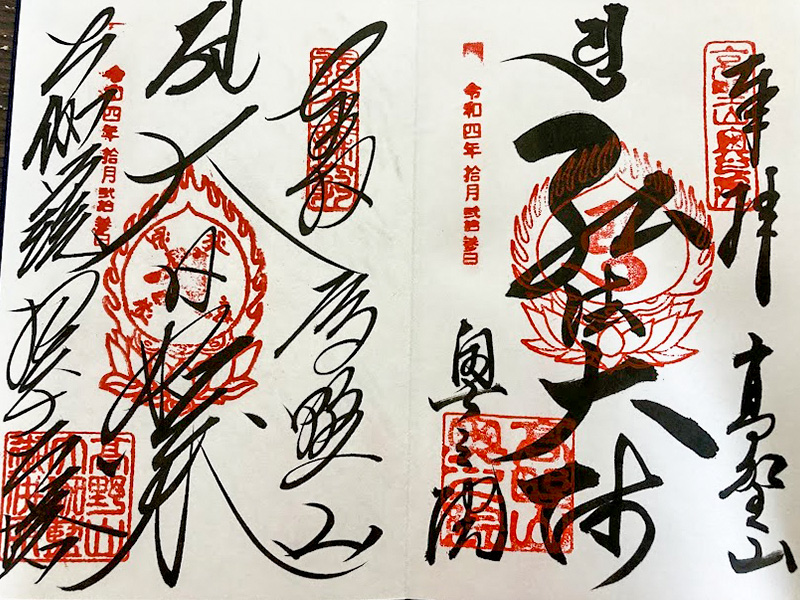
The goshuin stamp book I got features an old map of Mount Koya. It’s so stylish!

The 3-legged Crow Yatagarasu as Seen at Kumano Hongu Taisha (Wakayama)
This is the head shrine of the approximately 3,000 Kumano shrines located in Japan. You can find the three-legged Yatagarasu crow, which is a famous symbol of the Japan Football Association, all throughout the shrine grounds. This mythical creature is considered to be a messenger of the kami.

I found a black Yatagarasu-themed postbox in front of the shrine office too! The office sells Yatagarasu votive plaques that can be mailed as postcards. I think I’ll send a love letter to Bob!

But the goshuin stamps are not sold at this shrine office. There is another office that sells amulets and request a stamp.

So what do you think of my unique goshuin stamp collection? Some feature impressive, stylized calligraphy while others are colorful and mesmerizingly beautiful?
I hope you’re interested in the world of goshuin too now!
Goshuin are a fun way to learn more about shrines, temples, and Japanese culture, so I hope you can embrace this hobby too.
Kansai is full of historic shrines and temples, so be sure to take your goshuin book with you when you are out exploring!
Of course, you don’t want to pick up your goshuin stamps, without sending a prayer to the kami and Buddha.

Osaka Bob FAMILY
The contents of this page were current at the time it was posted, but may differ from the present.
Text visible in this map is based on information from Map Tiler and may differ from actual geographical names.







